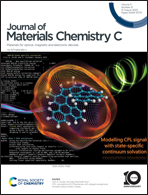The structural transformation of metal–organic frameworks towards 2D carbon for a desirable supercapacitor†
Abstract
Direct use of 2D carbon-based materials with robust energy efficiency and high specific surface area as commercial potential electrodes is highly workable, yet usually cannot showcase expected performance in terms of conductivity, specific capacitance, and cycling stability. Herein, we report on the fabrication of a distinct kind of porous structured carbon from zinc-based metal–organic framework (Zn-BTC) transformation by a convenient interfacial synthesis method. Specifically, Zn-BTC obtained by generating composition species through a controlled metal–ligand-chain reaction resulted in the reduction of ZnO and the volatilization of Zn, finally producing the proposed porous carbon. Experimental results and structural characterization reveal that the Zn-based MOFs after high pyrolysis not only produce many micropores and mesopores due to gasification and/or evaporation etching of Zn but also convert a high degree of crystalline carbon with a highly dense layered structure, resulting in more electrochemical optimized properties for pure 2D carbon. The resulting hybrid nanomaterials enable enhancement in both specific capacitance and cycling durability, with 62.5 F g−1 at 0.5 A g−1 and capacitance retentions of >90% after 30 000 continuous charge–discharge cycles, respectively. This study will open up a new avenue for the analysis of dynamic chemical processes at high temperatures and for designing highly ordered carbon-based materials for various electrochemical energy applications.

- This article is part of the themed collections: 1D/2D materials for energy, medicine, and devices and #MyFirstJMCC


 Please wait while we load your content...
Please wait while we load your content...